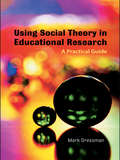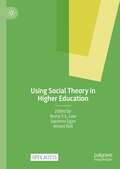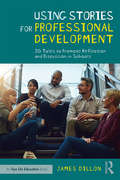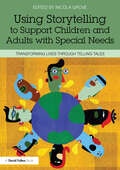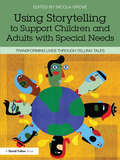- Table View
- List View
Using Simulations to Promote Learning in Higher Education: An Introduction
by John Paul Hertel Barbara Millis"Not only did I learn more substantive law than in any other course I've taken, but I learned why I needed to learn all those things." Alumnus of a legal simulation courseSimulations create and use a complete environment within which students can interact to apply theory and practice skills to real-world issues related to their discipline. Simulations constitute a powerful tool for learning. They allow teachers simultaneously to integrate multiple teaching objectives in a single process. They motivate students, provide opportunities for active participation to promote deep learning, develop interactive and communication skills, and link knowledge and theory to application.This book provides an introduction to the use of simulations - from creating simple scenarios that can be completed in a single class period, to extended, complex simulations that may encompass a semester's curriculum. Assuming no prior experience in their use, the authors provide a recipe approach to selecting and designing scenarios for all sizes of class; offer guidance on creating simulated environments to meet learning objectives; and practical advice on managing the process in the classroom through to the crucial processes of debriefing and assessment. The detailed concluding description of how to plan and manage a complex simulation -- complete with its sample scenario and examples of documentation - provides a rich demonstration of the process. This book will appeal to anyone, in virtually any field of study, looking for effective ways to bridge the gap between academic learning and discipline-specific practice.
Using Social Emotional Learning to Prevent School Violence: A Reference and Activity Guide
by Allison PaoliniUsing Social Emotional Learning to Prevent School Violence is an essential resource that seeks to close the existing gap in literature on ways to mitigate school violence, as well as to advocate for the integration of social emotional learning in schools. In an effort to create culturally responsive, student-centered, and secure school environments, this book outlines strategies that highlight the importance of collaboration between critical stakeholders in identifying and mitigating bullying, assisting students struggling with relationship building skills, grief and loss, and anger; particularly those that demonstrate the need for power and control or the desire for retaliation. Mental health issues are also taken into consideration. Proactive responses and best practices are exemplifed in order to equip struggling students with resources that foster their well-being and success. Dr. Paolini draws upon extensive research in her depiction of school violence in America’s education system and designs lesson plans and activities that address and align with each of the social emotional learning core competencies for both elementary and secondary school counselors. This book will be of interest to critical stakeholders in P-12 settings as well as those in higher education, particularly as a resource for graduate students training to become transformative school counselors.
Using Social Emotional Learning to Prevent School Violence: A Reference and Activity Guide
by Allison PaoliniUsing Social Emotional Learning to Prevent School Violence is an essential resource that seeks to close the existing gap in literature on ways to mitigate school violence, as well as to advocate for the integration of social emotional learning in schools. In an effort to create culturally responsive, student-centered, and secure school environments, this book outlines strategies that highlight the importance of collaboration between critical stakeholders in identifying and mitigating bullying, assisting students struggling with relationship building skills, grief and loss, and anger; particularly those that demonstrate the need for power and control or the desire for retaliation. Mental health issues are also taken into consideration. Proactive responses and best practices are exemplifed in order to equip struggling students with resources that foster their well-being and success. Dr. Paolini draws upon extensive research in her depiction of school violence in America’s education system and designs lesson plans and activities that address and align with each of the social emotional learning core competencies for both elementary and secondary school counselors. This book will be of interest to critical stakeholders in P-12 settings as well as those in higher education, particularly as a resource for graduate students training to become transformative school counselors.
Using Social Media Effectively in the Classroom: Blogs, Wikis, Twitter, and More
by Kay SeoThe rapid expansion of blogs, Twitter, wikis, and virtual worlds has dramatically transformed the landscape of education. Through highly accessible networks, these new media can integrate students into a learning community by enabling them to create, customize, and share content online. Using Social Media Effectively in the Classroom shows educators how to: utilize social media to best support learners resolve potential problems create a powerful sense of community within user-centered Web 2.0 technologies. Moving beyond basic explanations of technologies and how to use them, this book provides research-based, jargon-free, practical examples of what works, what doesn’t, and why when it comes to social media. Organized according to the systematic process of instructional design, contributors describe innovative strategies for incorporating social media into educational settings as well as significant issues to be taken into consideration at each phase of planning, designing, teaching, and evaluation.
Using Social Media Effectively in the Classroom: Blogs, Wikis, Twitter, and More
by Kay SeoThe rapid expansion of blogs, Twitter, wikis, and virtual worlds has dramatically transformed the landscape of education. Through highly accessible networks, these new media can integrate students into a learning community by enabling them to create, customize, and share content online. Using Social Media Effectively in the Classroom shows educators how to: utilize social media to best support learners resolve potential problems create a powerful sense of community within user-centered Web 2.0 technologies. Moving beyond basic explanations of technologies and how to use them, this book provides research-based, jargon-free, practical examples of what works, what doesn’t, and why when it comes to social media. Organized according to the systematic process of instructional design, contributors describe innovative strategies for incorporating social media into educational settings as well as significant issues to be taken into consideration at each phase of planning, designing, teaching, and evaluation.
Using Social Media in the Classroom: A Best Practice Guide (PDF)
by Megan Poore‘A book for every teacher’s bookshelf. This book gives a comprehensive overview of the tools and apps that can be used to help turn a mediocre teaching session into an outstanding one.’ - Cheryl Hine, Leeds City College ‘Megan Poore’s updated text is needed more than ever, as social media becomes increasingly integrated in many aspects of education. I would recommend it to all practising teachers and trainee teachers, whatever their subject.’ - Sue Howarth, University of Worcester This is an essential guide to using social media to enhance teaching and learning in schools. It combines practical information on using all forms of social media for educational purposes and provides indispensable advice on how to tackle issues arising from social media use in the classroom. Key topics include: using blogs, wikis, social media networks and podcasting, digital literacy and new modes of learning, digital participation, cyberbullying and understanding risk online. This second edition includes: · Reflective tasks in each chapter inviting you to critically consider important aspects of using social media in education. · Expanded coverage of game-based learning and mobile learning. · New examples tailored for use in primary and secondary schools. · A website including additional resources and handouts can be found at study.sagepub.com/poore2e. This is essential reading for anyone training to teach in schools, and experienced teachers seeking to improve their understanding of using social media for teaching in informed and appropriate ways.
Using Social Media in the Classroom: A Best Practice Guide
by Megan Poore‘A book for every teacher’s bookshelf. This book gives a comprehensive overview of the tools and apps that can be used to help turn a mediocre teaching session into an outstanding one.’ - Cheryl Hine, Leeds City College ‘Megan Poore’s updated text is needed more than ever, as social media becomes increasingly integrated in many aspects of education. I would recommend it to all practising teachers and trainee teachers, whatever their subject.’ - Sue Howarth, University of Worcester This is an essential guide to using social media to enhance teaching and learning in schools. It combines practical information on using all forms of social media for educational purposes and provides indispensable advice on how to tackle issues arising from social media use in the classroom. Key topics include: using blogs, wikis, social media networks and podcasting, digital literacy and new modes of learning, digital participation, cyberbullying and understanding risk online. This second edition includes: · Reflective tasks in each chapter inviting you to critically consider important aspects of using social media in education. · Expanded coverage of game-based learning and mobile learning. · New examples tailored for use in primary and secondary schools. · A website including additional resources and handouts can be found at study.sagepub.com/poore2e. This is essential reading for anyone training to teach in schools, and experienced teachers seeking to improve their understanding of using social media for teaching in informed and appropriate ways.
Using Social Theory in Educational Research: A Practical Guide
by Mark DressmanUsing Social Theory in Educational Research is organised to help practising educators and novice researchers who have little familiarity with social theory to: be introduced to major schools of social theory, their basic concepts, and their general applicability to educational issues develop an understanding of and appreciation for its potential to improve their own practice gain practical insight into how theory can function as a warrant, or support, for data interpretation through the use of multiple practical examples, learn how to integrate theory into their own work more effectively Selected Contents: 1. Getting Theoretical 2. An Illustrated Tour of How Theory Works (and Doesn’t Work) in Educational Research 3. Framing Research Theoretically, Part One: Planning and Data Collection 4. Framing Research Theoretically 5.When Research Meets Research
Using Social Theory in Educational Research: A Practical Guide
by Mark DressmanUsing Social Theory in Educational Research is organised to help practising educators and novice researchers who have little familiarity with social theory to: be introduced to major schools of social theory, their basic concepts, and their general applicability to educational issues develop an understanding of and appreciation for its potential to improve their own practice gain practical insight into how theory can function as a warrant, or support, for data interpretation through the use of multiple practical examples, learn how to integrate theory into their own work more effectively Selected Contents: 1. Getting Theoretical 2. An Illustrated Tour of How Theory Works (and Doesn’t Work) in Educational Research 3. Framing Research Theoretically, Part One: Planning and Data Collection 4. Framing Research Theoretically 5.When Research Meets Research
Using Social Theory in Higher Education
by Remy Y. S. Low Suzanne Egan Amani BellThis open access book offers a unique and refreshing view on working with social theory in higher education. Using engaging first-person accounts coupled with critical intellectual analysis, the authors demonstrate how theory is grappled with as part of an ongoing practice rather than a momentary disembodied encounter. In a structure that creates a space for relational dialogue, each chapter is followed by a response from another author, demonstrating the varied interpretive possibilities of social theory. Collectively the authors invite the reader to engage with them in questioning the usefulness of social theory in higher education teaching and research, in considering its possibilities and limits, and in experiencing the opportunity it offers to understand ourselves and our work differently. Written in a way that is scholarly yet accessible, the contributors explore how social theories can be used to think through issues that are emerging as key social and political concerns in higher education and beyond. The book will be of interest to advanced undergraduates, postgraduates, and early-career academics, as well as established scholars.
Using SPSS Syntax: A Beginner's Guide (PDF)
by Professor Jacqueline CollierSPSS syntax is the command language used by SPSS to carry out all of its commands and functions. In this book, Jacqueline Collier introduces the use of syntax to those who have not used it before, or who are taking their first steps in using syntax. Without requiring any knowledge of programming, the text outlines: - how to become familiar with the syntax commands; - how to create and manage the SPSS journal and syntax files; - and how to use them throughout the data entry, management and analysis process. Collier covers all aspects of data management from data entry through to data analysis, including managing the errors and the error messages created by SPSS. Syntax commands are clearly explained and the value of syntax is demonstrated through examples. This book also supports the use of SPSS syntax alongside the usual button and menu-driven graphical interface (GIF) using the two methods together, in a complementary way. The book is written in such a way as to enable you to pick and choose how much you rely on one method over the other, encouraging you to use them side-by-side, with a gradual increase in use of syntax as your knowledge, skills and confidence develop. This book is ideal for all those carrying out quantitative research in the health and social sciences who can benefit from SPSS syntax's capacity to save time, reduce errors and allow a data audit trail.
Using SPSS Syntax: A Beginner's Guide
by Professor Jacqueline CollierSPSS syntax is the command language used by SPSS to carry out all of its commands and functions. In this book, Jacqueline Collier introduces the use of syntax to those who have not used it before, or who are taking their first steps in using syntax. Without requiring any knowledge of programming, the text outlines: - how to become familiar with the syntax commands; - how to create and manage the SPSS journal and syntax files; - and how to use them throughout the data entry, management and analysis process. Collier covers all aspects of data management from data entry through to data analysis, including managing the errors and the error messages created by SPSS. Syntax commands are clearly explained and the value of syntax is demonstrated through examples. This book also supports the use of SPSS syntax alongside the usual button and menu-driven graphical interface (GIF) using the two methods together, in a complementary way. The book is written in such a way as to enable you to pick and choose how much you rely on one method over the other, encouraging you to use them side-by-side, with a gradual increase in use of syntax as your knowledge, skills and confidence develop. This book is ideal for all those carrying out quantitative research in the health and social sciences who can benefit from SPSS syntax's capacity to save time, reduce errors and allow a data audit trail.
Using Statistics: A Gentle Introduction (UK Higher Education OUP Humanities & Social Sciences Study Skills)
by Gordon RuggIF YOU'RE ENCOUNTERING STATISTICS FOR THE FIRST TIME, AND WANT A READABLE, SUPPORTIVE INTRODUCTION, THEN THIS IS THE BOOK FOR YOU.There are plenty of excellent stats books in the world, but very few of them are entertaining reading. One result is that many students are deterred by stats. But this book is different.Written in an informal style, it guides the reader gently through the field from the simplest descriptive statistics to multidimensional approaches. It's written in an accessible way, with few calculations and fewer equations, for readers from a broad set of academic disciplines ranging from archaeology to zoology.There are numerous illustrative examples that guide the reader through:How to answer various types of research questionHow to use different forms of analysisThe strengths and weaknesses of particular methodsMethods that may be useful but that don't usually appear in statistics booksIn this way, the book's emphasis is on understanding how statistics can be used to help answer research questions, rather than on the minute details of particular statistical tests.Using Statistics is key reading for students who are looking for help with quantitative projects, but would like a qualitative introduction that takes them gently through the process.
Using Stories for Professional Development: 35 Tales to Promote Reflection and Discussion in Schools
by James DillonThis book offers a selection of stories about teaching, learning, and school life that you can use in a variety of PD formats and settings. Grouped into four categories—students, teachers, administrators, and parents—these tales offer a powerful entry point for thinking and reflecting on your school environment in a new and meaningful way. Each brief tale is presented to spark a 10–15 minute group discussion that will help educators think more deeply about the complex, human problems they confront on a daily basis. Suggested questions and a brief commentary following each tale can be used to explore the issues embedded in the tale and, thereby, empower staff to generate creative responses to them. Ditch your "sit and get" professional development and "tap into the wisdom of the ages" by using these powerful tales to give educators the gift of time to think and talk about what it really means to educate hearts and minds.
Using Stories for Professional Development: 35 Tales to Promote Reflection and Discussion in Schools
by James DillonThis book offers a selection of stories about teaching, learning, and school life that you can use in a variety of PD formats and settings. Grouped into four categories—students, teachers, administrators, and parents—these tales offer a powerful entry point for thinking and reflecting on your school environment in a new and meaningful way. Each brief tale is presented to spark a 10–15 minute group discussion that will help educators think more deeply about the complex, human problems they confront on a daily basis. Suggested questions and a brief commentary following each tale can be used to explore the issues embedded in the tale and, thereby, empower staff to generate creative responses to them. Ditch your "sit and get" professional development and "tap into the wisdom of the ages" by using these powerful tales to give educators the gift of time to think and talk about what it really means to educate hearts and minds.
Using Stories to Support Learning and Development in Early Childhood: A Practical Guide
by Helen LumgairThis book is an exploration of story and its importance in early childhood. It provides a thorough theoretical foundation, and considers how to practically implement the use of stories to aid children's wellbeing and holistic development.The chapters cover topics including cognitive and emotional development, creativity, play, mathematics, language development, and trauma and healing. It is an ideal resource for early years practitioners, parents, and all those working in early childhood who are looking to encourage creativity, build agency and foster positive communication in children's lives.
Using Story: In Higher Education and Professional Development
by Jennifer A. MoonStory is everywhere in human lives and cultures and it features strongly in the processes of teaching and learning. Story can be called narrative, case study, critical incident, life history, anecdote, scenario, illustration or example, creative writing, storytelling; it is a unit of communication, it is in the products of the media industries, in therapy and in our daily acts of reflecting. Stories are 'told' in many ways - they are spoken, written, filmed, mimed or acted, presented as cartoons and in new media formats and through all these, they are associated with both teaching and learning processes but in different ways and at different levels. As a result of growing interest and simultaneous confusion about story, it is timely to untangle the various meanings of story so that we can draw out and extend its value and use. Using Story aims to clarify what we mean by story, to seek out where story occurs in education and life and to explore the processes by which we learn from story. In this way the book intends to ‘bring story into the open’ and improve its use. Building on her wealth of experience in the field, Jenny Moon explores the theory of story and demonstrates both its current uses and new ways in which to enrich and enliven teaching, learning and research processes. Ideal for anyone involved in education, personal or professional development or with a more general interest in story, the book begins by considering the range of what is meant by story, and then considers the theory behind the meanings. In the large final part of the book, Jenny provides a rich patchwork of different uses of story in education that cut across forms of story, story activities, disciplines and applications all of which will aid the use of story.
Using Story: In Higher Education and Professional Development
by Jennifer A. MoonStory is everywhere in human lives and cultures and it features strongly in the processes of teaching and learning. Story can be called narrative, case study, critical incident, life history, anecdote, scenario, illustration or example, creative writing, storytelling; it is a unit of communication, it is in the products of the media industries, in therapy and in our daily acts of reflecting. Stories are 'told' in many ways - they are spoken, written, filmed, mimed or acted, presented as cartoons and in new media formats and through all these, they are associated with both teaching and learning processes but in different ways and at different levels. As a result of growing interest and simultaneous confusion about story, it is timely to untangle the various meanings of story so that we can draw out and extend its value and use. Using Story aims to clarify what we mean by story, to seek out where story occurs in education and life and to explore the processes by which we learn from story. In this way the book intends to ‘bring story into the open’ and improve its use. Building on her wealth of experience in the field, Jenny Moon explores the theory of story and demonstrates both its current uses and new ways in which to enrich and enliven teaching, learning and research processes. Ideal for anyone involved in education, personal or professional development or with a more general interest in story, the book begins by considering the range of what is meant by story, and then considers the theory behind the meanings. In the large final part of the book, Jenny provides a rich patchwork of different uses of story in education that cut across forms of story, story activities, disciplines and applications all of which will aid the use of story.
Using Story Telling as a Therapeutic Tool with Children (Helping Children with Feelings)
by Margot SunderlandThis practical handbook begins with the philosophy and psychology underpinning the therapeutic value of story telling. It shows how to use story telling as a therapeutic tool with children and how to make an effective response when a child tells a story to you. It is an essential accompaniment to the "Helping Children with Feelings" series and covers issues such as: Why story telling is such a good way of helping children with their feelings? What resources you may need in a story-telling session? How to construct your own therapeutic story for a child? What to do when children tell stories to you? Things to do and say when working with a child's story.
Using Story Telling as a Therapeutic Tool with Children (Helping Children with Feelings)
by Margot SunderlandThis practical handbook begins with the philosophy and psychology underpinning the therapeutic value of story telling. It shows how to use story telling as a therapeutic tool with children and how to make an effective response when a child tells a story to you. It is an essential accompaniment to the "Helping Children with Feelings" series and covers issues such as: Why story telling is such a good way of helping children with their feelings? What resources you may need in a story-telling session? How to construct your own therapeutic story for a child? What to do when children tell stories to you? Things to do and say when working with a child's story.
Using Storytelling to Support Children and Adults with Special Needs: Transforming lives through telling tales
by Nicola GroveThis innovative and wide-ranging book shows how storytelling can open new worlds for learners with or without special educational needs. With sections that outline both therapeutic and educational approaches, the leading practitioners who contribute to this practical resource draw on their extensive experience, and distil their own approaches for the reader to use as inspiration for their own lessons. Providing a highly accessible combination of theory and practice, the contributors to this book: define their own approach to storytelling describe the principles and theory that underpin their practice demonstrate how they work with different types of story provide extensive case-studies and assessment frameworks for a range of different special needs and age ranges provide some ‘top tips’ for practitioners who want to start using stories in this way. Using Storytelling to Support Children and Adults with Special Needs will be of interest to all education professionals as well as therapists, youth workers, counsellors, and storytellers and theatre practitioners working in special education.
Using Storytelling to Support Children and Adults with Special Needs: Transforming lives through telling tales
by Nicola Grove Nicola GrovesThis innovative and wide-ranging book shows how storytelling can open new worlds for learners with or without special educational needs. With sections that outline both therapeutic and educational approaches, the leading practitioners who contribute to this practical resource draw on their extensive experience, and distil their own approaches for the reader to use as inspiration for their own lessons. Providing a highly accessible combination of theory and practice, the contributors to this book: define their own approach to storytelling describe the principles and theory that underpin their practice demonstrate how they work with different types of story provide extensive case-studies and assessment frameworks for a range of different special needs and age ranges provide some ‘top tips’ for practitioners who want to start using stories in this way. Using Storytelling to Support Children and Adults with Special Needs will be of interest to all education professionals as well as therapists, youth workers, counsellors, and storytellers and theatre practitioners working in special education.
Using Student Feedback for Successful Teaching
by Klaus Zierer Benedikt WisniewskiFeedback from students to teachers has been shown to have a major influence on students’ achievement. Although the use of feedback from students requires little time and investment, the exploration of this topic in recent years has focused primarily on that from teacher-to-student or teacher-to-teacher. This innovative book examines the much-neglected feedback path from student to teacher and provides an empirically founded and practice-oriented step-by-step guide for teachers who want to get feedback on their own teaching. Including a foreword by John Hattie, the authors shed light on the benefits, challenges, impact and academic discussion of student feedback. Topics include: an outline of the current state of research about feedback, including in the light of Visible Learning, and the essentials for translating this research into implementation in the classroom; the advantages of student-to-teacher feedback and how it is connected to good, effective teaching; the practicalities of putting student feedback into practice: finding the right questions to ask, professional discussion, and how to go about applying changes to your teaching; an exploration of combining digital technologies with the acquisition and evaluation of student feedback; the wider impact of feedback and how a "feedback culture" can transform not only individual teachers but whole schools. Using Student Feedback for Successful Teaching is an essential guide for experienced and newly-qualified teachers alike who are invested in their professional development and who strive to deliver the best quality teaching for their students.
Using Student Feedback for Successful Teaching
by Klaus Zierer Benedikt WisniewskiFeedback from students to teachers has been shown to have a major influence on students’ achievement. Although the use of feedback from students requires little time and investment, the exploration of this topic in recent years has focused primarily on that from teacher-to-student or teacher-to-teacher. This innovative book examines the much-neglected feedback path from student to teacher and provides an empirically founded and practice-oriented step-by-step guide for teachers who want to get feedback on their own teaching. Including a foreword by John Hattie, the authors shed light on the benefits, challenges, impact and academic discussion of student feedback. Topics include: an outline of the current state of research about feedback, including in the light of Visible Learning, and the essentials for translating this research into implementation in the classroom; the advantages of student-to-teacher feedback and how it is connected to good, effective teaching; the practicalities of putting student feedback into practice: finding the right questions to ask, professional discussion, and how to go about applying changes to your teaching; an exploration of combining digital technologies with the acquisition and evaluation of student feedback; the wider impact of feedback and how a "feedback culture" can transform not only individual teachers but whole schools. Using Student Feedback for Successful Teaching is an essential guide for experienced and newly-qualified teachers alike who are invested in their professional development and who strive to deliver the best quality teaching for their students.
Using Students' Assessment Mistakes and Learning Deficits to Enhance Motivation and Learning (Student Assessment for Educators)
by James H. McMillanBeing wrong is an integral part of the assessment process, and understanding how to learn from those mistakes, errors, and misconceptions helps educators and students get the most from their learning experience. In this practical volume, James H. McMillan shows why being wrong (sometimes) is an essential part of effective learning and how it can be used by teachers to motivate students and help develop positive achievement-related dispositions. The six concise chapters of Using Students’ Assessment Mistakes and Learning Deficits to Enhance Motivation and Learning show how mistakes affect students’ engagement, self-regulation, and knowledge, and how teachers can most effectively contextualize supposed failures to help students grow.




